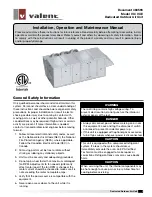
87
Indoor Coils
Indoor cooling/evaporator coils must be
cleaned regularly to maintain unit efficiency
and operation. Dirty evaporator coils will
eventually freeze up and often result in a
time consuming and expensive service call.
Clean filters will help to prevent dirt from
accumulating on cooling coils, however
cooling coils should be cleaned at least
annually by an HVAC professional.
Refrigeration Cycle
Satisfactory performance of the refrigeration
cycle can be determined by measuring
suction line superheat. In order to determine
if refrigerant flowing from the evaporator is
dry, ensure that the system has enough
refrigerant to produce liquid line subcooling,
but not so much to cause abnormally high
condensing temperatures (and pressures).
Refrigerant cycle analysis is best performed
in conditions that approach the conditions
where the air conditioner will be expected to
operate.
Brazed Plate Heat Exchanger Cleaning
Because of a normally high degree of
turbulence in brazed plate heat exchangers,
for many applications the heat exchanger
channels are self-cleaning. For applications
that are not self-cleaning (i.e. hard water at
high temperatures, etc.) or applications
where additional cleaning is desired, it is
possible to clean the brazed plate heat
exchanger by circulating a cleaning liquid.
Use a tank with weak acid, 5% phosphoric
acid (H3PO4) or, if the exchanger is
frequently
cleaned,
5%
oxalic
acid
(H2C2O4). Pump the cleaning liquid
through the exchanger. For optimum
cleaning, the cleaning solution flow rate
should be a minimum of 1.5 times the
normal flow rate, preferably in a back-flush
mode. After cleaning, the heat exchanger
must be rinsed with clean water. A solution
of 1-2% sodium hydroxide (NaOH) or
sodium bicarbonate (NaHCO) before the last
rinse ensures that all acid is neutralized.
E-Coated Coil Cleaning
Documented routine cleaning of e-coated
coils is required to maintain coating
warranty coverage.
Surface loaded fibers or dirt should be
removed prior to water rinse to prevent
restriction of airflow. If unable to back wash
the side of the coil opposite of the coils
entering air side, then surface loaded fibers
or dirt should be removed with a vacuum
cleaner. If a vacuum cleaner is not available,
a
soft non-metallic
bristle brush may be
used. In either case, the tool should be
applied in the direction of the fins. Coil
surfaces can be easily damaged (fin edges
bent over) if the tool is applied across the
fins.
Use of a water stream, such as a garden
hose, against a surface loaded coil will drive
the fibers and dirt into the coil. This will
make cleaning efforts more difficult. Surface
loaded fibers must be completely removed
prior to using low velocity clean water rinse.
A
monthly
clean
water
rinse
is
recommended for coils that are applied in
coastal or industrial environments to help to
remove chlorides, dirt, and debris. It is very
important
when
rinsing,
that
water
temperature is less than 130°F and pressure
is than 100 psig to avoid damaging the fin
edges. An elevated water temperature (not to
exceed 130°F) will reduce surface tension,
increasing the ability to remove chlorides
and dirt.
Electric shock hazard. Shut off all
electrical power to the unit to avoid
shock hazard or injury from rotating
parts.
WARNING
Summary of Contents for M2 Series
Page 2: ......
Page 5: ...5 Split System Piping Diagrams 98 M2 Series Startup Form 115 Maintenance Log 121 ...
Page 35: ...35 Table 1 Electric and Gas Heating Capacities ...
Page 38: ...38 Figure 5 M2 Series Unit Four Point Lifting ...
Page 39: ...39 Figure 6 M2 Series Unit Eight Point Lifting ...
Page 58: ...58 Figure 32 Supply Fan Banding ...
Page 95: ...95 Figure 52 Filter Layout Viewed from the Upstream Side of the Cooling Coil ...
Page 98: ...98 Split System Piping Diagrams Figure 53 A C Split System Piping Suction Down ...
Page 99: ...99 Figure 54 A C Split System Piping Suction Up ...
Page 100: ...100 Figure 55 A C with LAC Split System Piping Suction Up ...
Page 101: ...101 Figure 56 A C with Modulating Hot Gas Reheat Split System Piping Suction Down ...
Page 102: ...102 Figure 57 A C with Modulating Hot Gas Reheat Split System Piping Suction Up ...
Page 103: ...103 Figure 58 A C with Hot Gas Bypass Split System Piping Suction Down ...
Page 104: ...104 Figure 59 A C with Hot Gas Bypass Split System Piping Suction Up ...
Page 107: ...107 Figure 62 Heat Pump Split System Piping Suction Down ...
Page 108: ...108 Figure 63 Heat Pump Split System Piping Suction Up ...
Page 109: ...109 Figure 64 Heat Pump with Modulating Hot Gas Reheat Split System Piping Suction Down ...
Page 110: ...110 Figure 65 Heat Pump with Modulating Hot Gas Reheat Split System Piping Suction Up ...
Page 111: ...111 Figure 66 Heat Pump with Hot Gas Bypass Split System Piping Suction Down ...
Page 112: ...112 Figure 67 Heat Pump with Hot Gas Bypass Split System Piping Suction Up ...






































